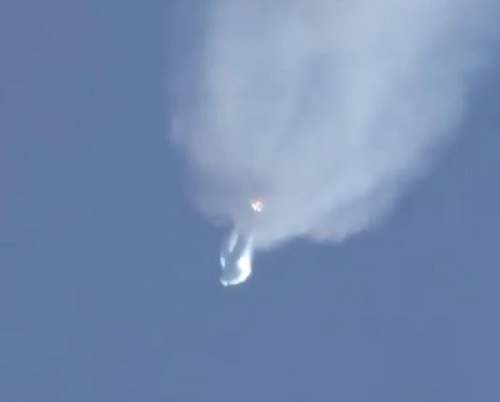Elon Musk is standing up to Russian imperialism: “It’s very questionable in light of international events. It seems like the wrong time to send hundreds of millions of dollars to the Kremlin.”

Not only is he standing up for doing the right thing, he’s standing up to two 800-lb. gorillas in the military-industrial-complex: Boeing and Lockheed Martin. They’re co-owners of United Launch Alliance, launch service providers to the U.S. Air Force. ULA buys RD-180 engines from NPO Energomash in Russia. Like most important businesses in Russia, it’s controlled by Putin’s Mafia State.
So the pussy lawyers had this to say…
“ULA and the U.S. Department of Justice filed motions to dissolve the preliminary injunction supporting ULA’s earlier statements that the purchase of the RD-180 engines from our suppliers and partners, RD AMROSS and NPO Energomash, does not violate the Ukraine sanctions.
“Unfortunately, SpaceX has made many public but unfounded speculations to create negative perceptions of a competitor solely for purposes of its own self-interest. This frivolous lawsuit caused unnecessary distraction of our executive branch leaders during a sensitive national security crisis.
“The letters from U.S. Departments of State, Treasury and Commerce clearly state that NPO Energomash is not subject to any of the current sanctions and that ULA’s continued purchase of the RD-180 does not directly or indirectly contravene the Ukraine sanctions.
“As a result, both ULA and the Department of Justice have requested that the injunction be immediately lifted.”
As he’s been doing to honest business people in Russia, Putin is now fucking with international business.
Take this business away from entities controlled by Russian mafia and give it to an honest, smart, hard-working American company: SpaceX.
Who would you rather do business with: innovative leaders or murderous managers?
And which launch system is more reliable? The American one, naturally. Atlas launches cost 40-50% more than Russian launches (86% success rate since December, 2010). It’s worth it to keep the engineering talent and expertise here in the U.S.
Here’s another Proton failure, an anomaly at T+9:00 with the third stage. With a beast of a bird onboard (Express-4R/«Экспресс-АМ4Р» — a Eurostar 3000 bus built by Astrium), its payload had 30 C-band, 28 Ku-band, 2 Ka-band, and 3 L-band transponders — so this has to hurt.
When Russian contractors work for American or European customers, everything they do has to be diligently verified. With only Russian customers, nobody really cares that much. This is a remnant of the Soviet system and must be changed. You can’t complete as a world-class company with this attitude.
Here’s the video (warning: there’s no dramatic explosion)…
The detail given comes to us courtesy of SpaceFlightNow.com
The Express AM4R spacecraft, worth approximately $200 million, was supposed to begin a 15-year mission beaming radio, television, broadband Internet and telephone services across Russia and neighboring countries.
But a few minutes after the 12,720-pound (5,770-kilogram) Express AM4R satellite launched from Baikonur, Russia’s primary space base, its Proton rocket ran into a problem.
The failure occurred during the third stage of the Proton’s ascent into orbit, according to a statement by the Khrunichev State Research and Production Space Center, the Moscow-based manufacturer of the Proton launcher.
An announcer declared an emergency during a live webcast of the launch, and Khrunichev’s statement also described the incident as an “emergency situation.”
Khrunichev said experts were analyzing telemetry to determine the cause of the failure.
A report by Interfax said debris from the rocket may have fallen the Altai or Amur regions of Russia’s Far East.
Spewing a brilliant flame of blue exhaust, the 19-story Proton rocket lifted off at 2142 GMT (5:42 p.m. EDT) to start a nine-hour flight to deploy the powerful European-built Express AM4R telecommunications satellite for Russian government and commercial customers.
The launch was at 3:42 a.m. local time at Baikonur.
The hydrazine-fueled rocket disappeared from the view of a ground-based tracking camera a few minutes later, with no visible signs of any trouble.
But a problem occurred about 545 seconds, or about 9 minutes, after liftoff, according to a report by the semi-official Itar-Tass news agency.
Another report by the Interfax media service said the time of the failure was about 500 seconds after launch.
Both of the times reported for the anomaly occurred during the firing of the Proton rocket’s third stage, which is powered by an RD-0213 main engine generating 131,000 pounds of thrust. A four-nozzle vernier steering engine is also mounted on the third stage to keep the rocket pointed in the right direction.
The rocket’s guidance, navigation and control system is a triple-redundant digital avionics package on the third stage.
Thursday’s mishap marks the fifth launch failure of the Proton rocket or its Breeze M upper stage in 36 flights since December 2010. Another Proton/Breeze M mission put the Russian Yamal 402 communications satellite in the wrong orbit, but the spacecraft was able to boot itself to the correct location.
The string of mishaps has brought focus on the quality control procedures of Khrunichev and its suppliers, with the Russian space contrator announcing expanded inspections, video monitoring in its factories and other measures to bolster the Proton’s reliability.
I suspect commercial payload customer on the Proton manifest are scrambling: Express AM6, Inmarsat 5 F2, ASTRA 2G and Turksat 4B.

 Great news! The
Great news! The 






